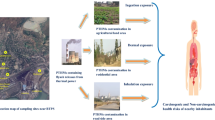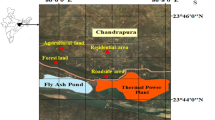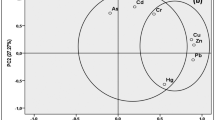Abstract
The present study was intended to determine the potentially toxic elements (PTEs) concentration in fly ash (FA), soil, plant, and vegetable to assess the impacts of pollution on the nearby areas of coal-fired thermal power plant (TPP). The PTEs concentrations (mg/kg) in FA were Cr (48–74) > Pb (41–65) > Cd (7.4–9.7) > As (3.19–4.43) > Hg (0.518–0.598). The contamination factor (Cf) for Cd was highest in agricultural soil (Cf = 22) followed by roadside soil (Cf = 20), and forest soil (Cf = 15), which showed that the soil was strongly polluted due to the presence of Cd. The ecological risk index (ERI) in the topsoil of roadside area was also very high (1130), due to the high value of ecological risk factor of Cd (898) and Hg (213). The health risk associated with the intake of soil containing PTEs were also estimated by calculating hazard index (HI), and the values showed that the risk posed to children was minimum (HI < 1). But in case of roadside area, the HI was very close to one (0.975) indicating that the prolong exposure may pose severe health risk. The bioaccumulation coefficient of all PTEs for Albizia lebbeck and Madhuca longifolia were < 1, indicating less PTEs accumulation in the plant species. The hazard quotient of all PTEs (except of Hg) through vegetable consumption (Allium cepa and Raphanus sativus) was > 1, which signifies that the long-time consumption of contaminated vegetables may cause severe risk to the people.






Similar content being viewed by others
References
Agrawal, P., Mittal, A., Prakash, R., Kumar, M., Singh, T. B., & Tripathi, S. K. (2010). Assessment of contamination of soil due to heavy metals around coal fired thermal power plants at Singrauli region of India. Bulletin of Environmental Contamination and Toxicology, 85, 219–223.
Allen, S. E., Grimshaw, H. M., Parkinson, J. A., & Quarmby, C. (1974). Chemical analysis of ecological materials. Hoboken: Blackwell Scientific Publications.
Alloway, B. J. (2013). Heavy metals in soils: trace metals and metalloids in soils and their bioavailability. Environmental Pollution (Vol. 22). Berlin: Springer Science & Business Media.
ASTM. (2006). D6414; Standard test methods for total mercury in coal and coal combustion residues by acid extraction or wet oxidation/cold vapour atomic absorption.
Augustsson, A., Uddh-Söderberg, T., Filipsson, M., Helmfrid, I., Berglund, M., Karlsson, H., & Alriksson, S. (2018). Challenges in assessing the health risks of consuming vegetables in metal-contaminated environments. Environment International, 113, 269–280.
Bartoňová, L., Čech, B., Ruppenthalová, L., Majvelderova, V., Juchelková, D., & Klika, Z. (2012). Effect of unburned carbon content in fly ash on the retention of 12 elements out of coal-combustion flue gas. Journal of Environmental Sciences, 24, 1624–1629.
Belviso, C., Cavalcante, F., Di Gennaro, S., Palma, A., Ragone, P., & Fiore, S. (2015). Mobility of trace elements in fly ash and in zeolitised coal fly ash. Fuel, 144, 369–379.
Bidar, G., Waterlot, C., Verdin, A., Proix, N., Courcot, D., Détriché, S., & Douay, F. (2016). Sustainability of an in situ aided phytostabilisation on highly contaminated soils using fly ashes: effects on the vertical distribution of physicochemical parameters and trace elements. Journal of Environmental Management, 171, 204–216.
Brigden, K., & Santillo, D. (2002). Heavy metal and metalloid content of fly ash collected from the Sual, Mauban and Masinloc coal-fired power plants in the Philippines, 2002. Exeter: University of Exeter.
Chen, X., Liu, M., Ma, J., Liu, X., Liu, D., Chen, Y., & Qadeer, A. (2017). Health risk assessment of soil heavy metals in housing units built on brownfields in a city in China. Journal of Soils and Sediments, 17, 1741–1750.
Doabi, S. A., Karami, M., Afyuni, M., & Yeganeh, M. (2018). Pollution and health risk assessment of heavy metals in agricultural soil, atmospheric dust and major food crops in Kermanshah province, Iran. Ecotoxicology and Environmental Safety, 163, 153–164.
Dragović, S., Ćujić, M., Slavković-Beškoski, L., Gajić, B., Bajat, B., Kilibarda, M., & Onjia, A. (2013). Trace element distribution in surface soils from a coal burning power production area: a case study from the largest power plant site in Serbia. Catena, 104, 288–296.
Frimpong, S. K., & Koranteng, S. S. (2019). Levels and human health risk assessment of heavy metals in surface soil of public parks in Southern Ghana. Environmental Monitoring and Assessment, 191, 588.
Guerra, F., Trevizam, A. R., Muraoka, T., Marcante, N. C., & Canniatti-Brazaca, S. G. (2012). Heavy metals in vegetables and potential risk for human health. Scientia Agricola, 69, 54–60.
Güleç, N., Günal, B. Ç., & Erler, A. (2001). Assessment of soil and water contamination around an ash-disposal site: a case study from the Seyitömer coal-fired power plant in western Turkey. Environmental Geology, 40, 331–344.
Guney, M., Karatas, T., Ozkul, C., Akyol, N. H., & Acar, R. U. (2020). Contamination by As, Hg, and Sb in a region with geogenic As anomaly and subsequent human health risk characterization. Environmental Monitoring and Assessment, 192, 1–16.
Hakanson, L. (1980). An ecological risk index for aquatic pollution control. A sedimentological approach. Water Research, 14, 975–1001.
Hossain, M. S., Ahmed, F., Abdullah, A. T. M., Akbor, M. A., & Ahsan, M. A. (2015). Public health risk assessment of heavy metal uptake by vegetables grown at a waste-water-irrigated site in Dhaka, Bangladesh. Journal of Health and Pollution, 5, 78–85.
Huang, X., Hu, J., Qin, F., Quan, W., Cao, R., Fan, M., & Wu, X. (2017). Heavy metal pollution and ecological assessment around the Jinsha Coal-Fired Power Plant (China). International Journal of Environmental Research and Public Health, 14, 1589.
Jambhulkar, H. P., & Juwarkar, A. A. (2009). Assessment of bioaccumulation of heavy metals by different plant species grown on fly ash dump. Ecotoxicology and Environmental Safety, 72, 1122–1128.
Kumar, V., Sharma, A., Kaur, P., Sidhu, G. P. S., Bali, A. S., Bhardwaj, R., et al. (2019). Pollution assessment of heavy metals in soils of India and ecological risk assessment: a state-of-the-art. Chemosphere, 216, 449–462.
Li, N., Kang, Y., Pan, W., Zeng, L., Zhang, Q., & Luo, J. (2015). Concentration and transportation of heavy metals in vegetables and risk assessment of human exposure to bioaccessible heavy metals in soil near a waste-incinerator site, South China. Science of the Total Environment, 521, 144–151.
Li, R., Wu, H., Ding, J., Fu, W., Gan, L., & Li, Y. (2017). Mercury pollution in vegetables, grains and soils from areas surrounding coal-fired power plants. Scientific Reports, 7, 46545.
Liu, X., Song, Q., Tang, Y., Li, W., Xu, J., Wu, J., & Brookes, P. C. (2013). Human health risk assessment of heavy metals in soil–vegetable system: a multi-medium analysis. Science of the Total Environment, 463, 530–540.
Lokeshappa, B., & Dikshit, A. K. (2012). Behaviour of metals in coal fly ash ponds. APCBEE Procedia, 1, 34–39.
Lomonte, C., Gregory, D., Baker, A. J., & Kolev, S. D. (2008). Comparative study of hotplate wet digestion methods for the determination of mercury in biosolids. Chemosphere, 72, 1420–1424.
Luo, X. S., Ding, J., Xu, B., Wang, Y. J., Li, H. B., & Yu, S. (2012). Incorporating bioaccessibility into human health risk assessments of heavy metals in urban park soils. Science of the Total Environment, 424, 88–96.
Maiti, S. K. (2012). Ecorestoration of the coalmine degraded lands. Berlin: Springer Science & Business Media.
Maiti, S. K., & Jaiswal, S. (2008). Bioaccumulation and translocation of metals in the natural vegetation growing on fly ash lagoons: a field study from Santaldih thermal power plant, West Bengal, India. Environmental Monitoring and Assessment, 136, 355–370.
Maiti, S. K., & Nandhini, S. (2006). Bioavailability of metals in fly ash and their bioaccumulation in naturally occurring vegetation: a pilot scale study. Environmental Monitoring and Assessment, 116, 263–273.
Mandal, A., & Sengupta, D. (2006). An assessment of soil contamination due to heavy metals around a coal-fired thermal power plant in India. Environmental Geology, 51, 409–420.
Noli, F., & Tsamos, P. (2016). Concentration of heavy metals and trace elements in soils, waters and vegetables and assessment of health risk in the vicinity of a lignite-fired power plant. Science of the Total Environment, 563, 377–385.
Özkul, C. (2016). Heavy metal contamination in soils around the Tunçbilek thermal power plant (Kütahya, Turkey). Environmental Monitoring and Assessment, 188, 284.
Pandey, S. K., & Bhattacharya, T. (2019). Mobility, Ecological risk and change in surface morphology during sequential chemical extraction of heavy metals in fly ash: a case study. Environmental Technology and Innovation, 13, 373–382.
Park, C. H., Eom, Y., Lee, L. J. E., & Lee, T. G. (2013). Simple and accessible analytical methods for the determination of mercury in soil and coal samples. Chemosphere, 93, 9-13.
Pastrana-Corral, M. A., Wakida, F. T., Temores-Peña, J., Rodriguez-Mendivil, D. D., García-Flores, E., Piñon-Colin, T. D. J., & Quiñonez-Plaza, A. (2017). Heavy metal pollution in the soil surrounding a thermal power plant in Playas de Rosarito, Mexico. Environmental Earth Sciences, 76, 583.
Patel, K. S., Sharma, R., Dahariya, N. S., Yadav, A., Blazhev, B., Matini, L., & Hoinkis, J. (2015). Heavy metal contamination of tree leaves. American Journal of Analytical Chemistry, 6, 687.
Pietrzykowski, M., Woś, B., Pająk, M., Wanic, T., Krzaklewski, W., & Chodak, M. (2018). Reclamation of a lignite combustion waste disposal site with alders (Alnus sp.): assessment of tree growth and nutrient status within 10 years of the experiment. Environmental Science and Pollution Research, 25, 17091–17099.
Pöykiö, R., Mäkelä, M., Watkins, G., Nurmesniemi, H., & Olli, D. A. H. L. (2016). Heavy metals leaching in bottom ash and fly ash fractions from industrial-scale BFB-boiler for environmental risks assessment. Transactions of Nonferrous Metals Society of China, 26, 256–264.
Raj, D., & Maiti, S. K. (2019). Sources, toxicity, and remediation of mercury: an essence review. Environmental Monitoring and Assessment, 191, 566.
Roba, C., Roşu, C., Piştea, I., Ozunu, A., & Baciu, C. (2016). Heavy metal content in vegetables and fruits cultivated in Baia Mare mining area (Romania) and health risk assessment. Environmental Science and Pollution Research, 23, 6062–6073.
Sengupta, S., Chatterjee, T., Ghosh, P. B., & Saha, T. (2010). Heavy metal accumulation in agricultural soils around a coal fired thermal power plant (Farakka) in India. Journal of Environmental Science & Engineering, 52, 299–306.
Tozsin, G. (2014). Hazardous elements in soil and coal from the Oltu coal mine district, Turkey. International Journal of Coal Geology, 131, 1–6.
Turekian, K. K., & Wedepohl, K. H. (1961). Distribution of the elements in some major units of the earth's crust. Geological Society of America Bulletin, 72, 175–192.
USEPA. (1989). Risk Assessment Guidance for Superfund (RAGS), volume I. Human Health Evaluation Manual (HHEM)—part A, baseline risk assessment. Office of emergency and remedial response [EPA/540/1-89/002], Washington DC.
USEPA. (1996). Method 3050B: acid digestion of sediments, sludges and soils, revision 2.
USEPA (2001). Supplemental guidance for developing soil screening levels for superfund sites. OSWER 9355.4-24. Office of Solid Waste and Emergency Response. US Environmental Protection Agency. Washington (DC). http://www.epa.gov/superfund/resou rces/soil/ssgmarch01.pdf. Accessed 11 Feb 2019.
USEPA. (2002). Supplemental guidance for developing soil screening levels for superfund sites. Office of Solid Waste and Emergency Response [OSWER 9355.4-24], Washington, DC.
USEPA. (2007a). Method 7471B, mercury in solid or semisolid waste (Manual Cold Vapor Technique), revision 2.
USEPA. (2007b). Method 7473: mercury in solids and solution by thermal decomposition. Amalgamation and atomic absorption spectrophotometry, Washington, DC.
USEPA. (2011). Exposure factors handbook 2011 edition (Final). http://cfpub.epa.gov/ncea/risk/recordisplay.cfm?deid=23625 2. Accessed 11 Feb 2019.
USEPA. (2015). Integrated Risk Information System, vol. 2015 http://www.epa.gov/iris. Accessed 25 Nov 2019.
Varol, M. (2011). Assessment of heavy metal contamination in sediments of the Tigris River (Turkey) using pollution indices and multivariate statistical techniques. Journal of Hazardous Materials, 195, 355–364.
Verma, S. K., Masto, R. E., Gautam, S., Choudhury, D. P., Ram, L. C., Maiti, S. K., & Maity, S. (2015). Investigations on PAHs and trace elements in coal and its combustion residues from a power plant. Fuel, 162, 138–147.
Woś, B., Sroka, K., Józefowska, A., & Pietrzykowski, M. (2019). Mercury concentration in Technosols and alder tissue from a plantation on a combustion waste disposal site. Water, Air, & Soil Pollution, 230, 259.
Xiao, X., Zhang, J., Wang, H., Han, X., Ma, J., Ma, Y., & Luan, H. (2020). Distribution and health risk assessment of potentially toxic elements in soils around coal industrial areas: a global meta-analysis. Science of the Total Environment, 713, 135292.
Yang, Q., Li, Z., Lu, X., Duan, Q., Huang, L., & Bi, J. (2018). A review of soil heavy metal pollution from industrial and agricultural regions in China: pollution and risk assessment. Science of the Total Environment, 642, 690–700.
Yu, J. G., Yue, B. Y., Wu, X. W., Liu, Q., Jiao, F. P., Jiang, X. Y., & Chen, X. Q. (2016). Removal of mercury by adsorption: a review. Environmental Science and Pollution Research, 23, 5056–5076.
Zhang, P., Qin, C., Hong, X., Kang, G., Qin, M., Yang, D., Pang, B., Li, Y., He, J., & Dick, R. P. (2018). Risk assessment and source analysis of soil heavy metal pollution from lower reaches of Yellow River irrigation in China. Science of the Total Environment, 633, 1136–1147.
Acknowledgements
The authors are grateful to the Indian Institute of Technology (Indian School of Mines), Dhanbad, India, for providing laboratories facilities to conduct the research work. The author D. Raj acknowledges the Ministry of Education, Government of India, for conferring the scholarship throughout the research period.
Author information
Authors and Affiliations
Corresponding author
Ethics declarations
Conflict of interest
The authors declare that there is no conflict of interest.
Additional information
Publisher’s note
Springer Nature remains neutral with regard to jurisdictional claims in published maps and institutional affiliations.
Electronic supplementary material
ESM 1
(DOCX 17 kb).
Rights and permissions
About this article
Cite this article
Raj, D., Maiti, S.K. Risk assessment of potentially toxic elements in soils and vegetables around coal-fired thermal power plant: a case study of Dhanbad, India. Environ Monit Assess 192, 699 (2020). https://doi.org/10.1007/s10661-020-08643-1
Received:
Accepted:
Published:
DOI: https://doi.org/10.1007/s10661-020-08643-1




